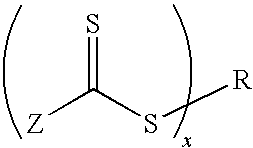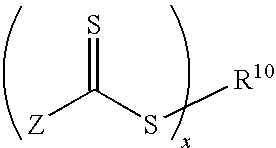Biomedical devices
- Summary
- Abstract
- Description
- Claims
- Application Information
AI Technical Summary
Benefits of technology
Problems solved by technology
Method used
Image
Examples
example 1
Preparation of Ethyl α-(o-Ethyl Xanthyl) Proprionate Having the Following Structure
[0106]
[0107]A 500 mL round bottom 3 neck flask was fitted with a magnetic stirrer, nitrogen inlet, and a temperature probe. Ethyl-2-bromo propionate (27.2 g) and 500 mL absolute ethanol were combined and stirred for 20 minutes under nitrogen. The reaction flask was placed in an ice / water bath at 0° C. Potassium O-ethyl xanthate (26.4 g) was slowly added using a powder funnel. The funnel was rinsed with an additional 50 mL of ethanol. The reaction flask was allowed to stir for an additional 24 hours at room temperature. Deionized water (250 mL) was then added to the reaction flask. The crude mixture was extracted 4 times with 200 mL of 2:1 hexane:ethyl ether retaining the organic layers. The combined organic layers were dried over sodium sulfate, filtered and solvent was removed under reduced pressure to obtain 32.22 grams of the desired product (a 97% yield).
example 2
Preparation of α-(Ethyl Xanthyl) Toluene Having the Following Structure
[0108]
[0109]A 250 mL round bottom 3 neck flask was fitted with a magnetic stirrer, nitrogen inlet, Freidrich's condenser, and a temperature probe. After absolute ethanol (125 mL), and benzyl bromide (14.4 g) were added, the reaction flask was placed in an ice / water bath at 0° C. and stirred for 1 hour. Potassium O-ethyl xanthate (17.63 g) was added slowly to the reaction flask using a powder funnel. The reaction flask was stirred for an additional 16 hours at room temperature and 200 mL of purified water was added to the flask. The crude mixture was extracted 3 times with 200 mL of 2:1 pentane:ethyl ether retaining the organic layers. The combined organic layers were dried over anhydrous sodium sulfate, filtered and solvent was removed under reduced pressure leaving 15.09 grams (an 84.6% yield) of the desired product.
example 3
Preparation of (1-Phenyl Ethyl) Ethyl Xanthate Having the Following Structure
[0110]
[0111]A 500 mL round bottom 3 neck flask was fitted with a magnetic stirrer, nitrogen inlet, and a temperature probe, 1-bromoethyl benzene (20.5 mL) and 200 mL absolute ethanol were added. The reaction flask was placed in an ice / water bath at 0° C. Potassium O-ethyl xanthate was added slowly using a powder funnel rinsed into the reaction flask with an additional 100 mL ethanol. The reaction flask was allowed to stir for an additional 24 hours at room temperature and then 250 mL of purified water was added. The crude mixture was extracted 4 times with 200 mL of 2:1 heptane:ethyl ether retaining the organic layers. The combined organic layers were dried over anhydrous sodium sulfate, filtered and the solvent was removed under reduced pressure to yield 31.42 grams of crude product. A portion, 15 grams, of the crude product was eluted from a silica gel column using hexane to give 12.81 grams of the pure p...
PUM
| Property | Measurement | Unit |
|---|---|---|
| Volume | aaaaa | aaaaa |
| Volume | aaaaa | aaaaa |
| Volume | aaaaa | aaaaa |
Abstract
Description
Claims
Application Information
 Login to View More
Login to View More - R&D
- Intellectual Property
- Life Sciences
- Materials
- Tech Scout
- Unparalleled Data Quality
- Higher Quality Content
- 60% Fewer Hallucinations
Browse by: Latest US Patents, China's latest patents, Technical Efficacy Thesaurus, Application Domain, Technology Topic, Popular Technical Reports.
© 2025 PatSnap. All rights reserved.Legal|Privacy policy|Modern Slavery Act Transparency Statement|Sitemap|About US| Contact US: help@patsnap.com



